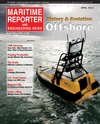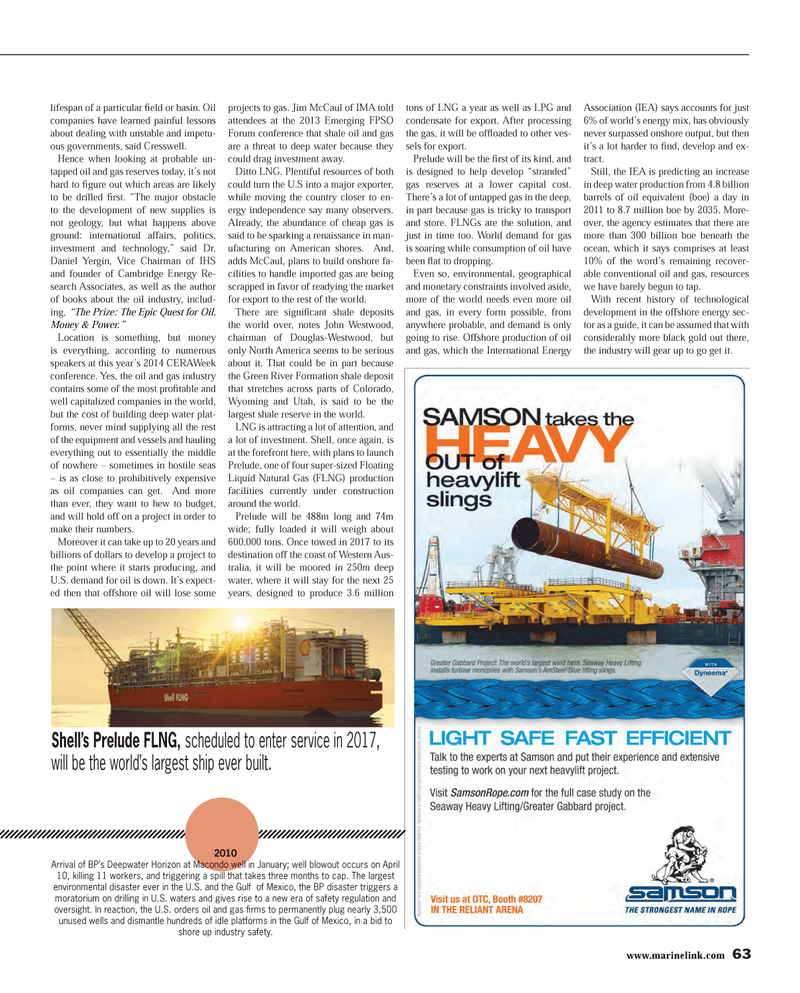
Page 3rd Cover: of Maritime Reporter Magazine (April 2014)
Offshore Edition
Read this page in Pdf, Flash or Html5 edition of April 2014 Maritime Reporter Magazine
www.marinelink.com 63lifespan of a particular Þ eld or basin. Oil companies have learned painful lessons about dealing with unstable and impetu-ous governments, said Cresswell.Hence when looking at probable un-tapped oil and gas reserves today, it?s not hard to Þ gure out which areas are likely to be drilled Þ rst. ?The major obstacle to the development of new supplies is not geology, but what happens above ground: international affairs, politics, investment and technology,? said Dr. Daniel Yergin, Vice Chairman of IHS and founder of Cambridge Energy Re- search Associates, as well as the author of books about the oil industry, includ- ing, ?The Prize: The Epic Quest for Oil, Money & Power.? Location is something, but money is everything, according to numerous speakers at this year?s 2014 CERAWeek conference. Yes, the oil and gas industry contains some of the most proÞ table and well capitalized companies in the world, but the cost of building deep water plat-forms, never mind supplying all the rest of the equipment and vessels and hauling everything out to essentially the middle of nowhere ? sometimes in hostile seas ? is as close to prohibitively expensive as oil companies can get. And more than ever, they want to hew to budget, and will hold off on a project in order to make their numbers. Moreover it can take up to 20 years and billions of dollars to develop a project to the point where it starts producing, and U.S. demand for oil is down. It?s expect- ed then that offshore oil will lose some projects to gas. Jim McCaul of IMA told attendees at the 2013 Emerging FPSO Forum conference that shale oil and gas are a threat to deep water because they could drag investment away. Ditto LNG. Plentiful resources of both could turn the U.S into a major exporter, while moving the country closer to en-ergy independence say many observers. Already, the abundance of cheap gas is said to be sparking a renaissance in man-ufacturing on American shores. And, adds McCaul, plans to build onshore fa-cilities to handle imported gas are being scrapped in favor of readying the market for export to the rest of the world. There are signiÞ cant shale deposits the world over, notes John Westwood, chairman of Douglas-Westwood, but only North America seems to be serious about it. That could be in part because the Green River Formation shale deposit that stretches across parts of Colorado, Wyoming and Utah, is said to be the largest shale reserve in the world. LNG is attracting a lot of attention, and a lot of investment. Shell, once again, is at the forefront here, with plans to launch Prelude, one of four super-sized Floating Liquid Natural Gas (FLNG) production facilities currently under construction around the world. Prelude will be 488m long and 74m wide; fully loaded it will weigh about 600,000 tons. Once towed in 2017 to its destination off the coast of Western Aus- tralia, it will be moored in 250m deep water, where it will stay for the next 25 years, designed to produce 3.6 million tons of LNG a year as well as LPG and condensate for export. After processing the gas, it will be ofß oaded to other ves- sels for export. Prelude will be the Þ rst of its kind, and is designed to help develop ?stranded? gas reserves at a lower capital cost. There?s a lot of untapped gas in the deep, in part because gas is tricky to transport and store. FLNGs are the solution, and just in time too. World demand for gas is soaring while consumption of oil have been ß at to dropping. Even so, environmental, geographical and monetary constraints involved aside, more of the world needs even more oil and gas, in every form possible, from anywhere probable, and demand is only going to rise. Offshore production of oil and gas, which the International Energy Association (IEA) says accounts for just 6% of world?s energy mix, has obviously never surpassed onshore output, but then it?s a lot harder to Þ nd, develop and ex- tract. Still, the IEA is predicting an increase in deep water production from 4.8 billion barrels of oil equivalent (boe) a day in 2011 to 8.7 million boe by 2035. More- over, the agency estimates that there are more than 300 billion boe beneath the ocean, which it says comprises at least 10% of the word?s remaining recover- able conventional oil and gas, resources we have barely begun to tap.With recent history of technological development in the offshore energy sec- tor as a guide, it can be assumed that with considerably more black gold out there, the industry will gear up to go get it. Shell?s Prelude FLNG, scheduled to enter service in 2017, will be the world?s largest ship ever built. 2010Arrival of BP?s Deepwater Horizon at Macondo well in January; well blowout occurs on April 10, killing 11 workers, and triggering a spill that takes three months to cap. The largest environmental disaster ever in the U.S. and the Gulf of Mexico, the BP disaster triggers a moratorium on drilling in U.S. waters and gives rise to a new era of safety regulation and oversight. In reaction, the U.S. orders oil and gas rms to permanently plug nearly 3,500 unused wells and dismantle hundreds of idle platforms in the Gulf of Mexico, in a bid to shore up industry safety. MR #4 (56-65).indd 63MR #4 (56-65).indd 634/7/2014 3:17:16 PM4/7/2014 3:17:16 PM

 62
62

 4th Cover
4th Cover
